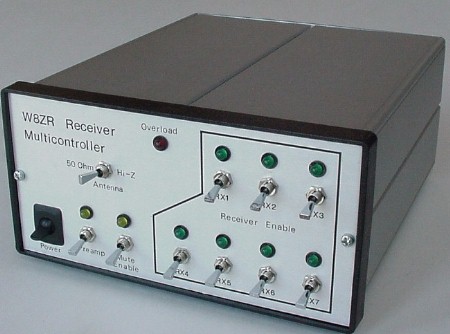Overview
| Welcome to the website for my homebrew "HF Receiver Multicontroller," described in the May 2004 issue of QST. Click on the above navigation panel for technical details, answers to FAQs, schematic diagrams, assembly instructions and other information. [NOTE: Circuit boards and enclosures are no longer available for sale.]You can also post a message to the multicontroller discussion group. I hope you find the site useful and that you'll email me your comments and suggestions. Let's all do our part to keep the homebrew art alive! Thanks! ---Jim Garland W8ZR |
 |
WHAT IS IT? The W8ZR Multicontroller is a broadband antenna distribution amplifier for hams and SWLs who have several receivers and need a convenient way to switch among them. It has inputs for both 50 ohm and high-Z antennas, with active outputs for up to 8 receivers. |
| In addition, the multicontroller has a control input that can be used to mute simultaneously all the connected receivers. Hook up the control jack to your transceiver's external relay line and all the receivers in your station will mute when you transmit. An overload circuit automatically disconnects the receivers if dangerous RF voltage is induced onto your receiving antenna. |
|
| Another useful feature is a wideband +12 dB low noise preamplifier to perk up older vacuum tube receivers and help compensate for poor antennas. In addition, the high-Z antenna input can be used to match short wire antennas to 50 ohm receivers. What this all means is that the multicontroller can greatly simplify your station's operation, since you won't have to hook up a snarl of cables when you want to change, evaluate, and compare your receivers. | |